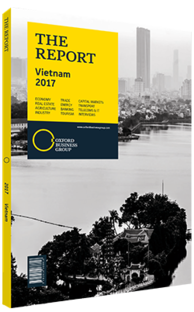Investment
In order to maintain the exceptionally good growth rate of around 6.5% in 2017-20 and successfully restructure the economy, Vietnam needs $250bn of investment, equivalent to approximately 25% of GDP, in the period. Foreign direct investment (FDI) and the public sector have historically accounted for 25% and 35%, respectively, of total investment. In recent years FDI disbursement has become increasingly important in total investment and GDP growth. Given the disbursement schedule, FDI might account for 30% of investment demand, equivalent to 60% of the current undisbursed FDI registration. The public sector, however, has limited investment capacity, as government debt has reached its limit, and investment efficiency has been low.
Private Sector Investment
The government is encouraging the private sector, including privatised/ equitised state-owned enterprises (SOEs), to invest a total of $100bn in the next four years. With a credit growth rate of 15-17% per annum, banks’ credit lines and companies’ organic cash flows might be able to meet this investment demand. However, Vietnamese companies have relatively high leverage ratios, and equity capital will be needed to ensure financial stability. Moreover, corporates, especially the big ones, prefer corporate bonds over bank loans and are ready to attract fixed-income investors with attractive yields.
According to the government’s medium-term fiscal plan, the state will receive $11bn from selling its stakes in SOEs. Currently 174 companies are due to be equitised or privatised, while the government continues selling stakes in hundreds of other companies. The selling list is tentative, as available-for-sale stakes are much bigger than the medium-term budget. Local governments, including in Hanoi and Ho Chi Minh City, also are also under pressure to sell their stakes in SOEs and properties to finance infrastructure investments.
Fixing The Issues
Despite attractive offerings, Vietnam’s equity market, in comparison with regional markets, remains underdeveloped with a non-standardised transaction system, weak liquidity, simple products and an immature local wealth management industry. The government acknowledges this and is making efforts to address the issues. In 2015 it removed the foreign ownership limits for companies operating in most industries. In 2016 the settlement period was shortened by one to two days, the derivative market began developing and public companies were pushed to register on the Unlisted Public Company Market (UPCoM). Hence, market capitalisation (including UPCoM) increased by 31%, while the daily transaction value improved by 19% in 2016. Although these were the most significant changes in years, they still fell short of investors’ expectations.
Big Changes
The government is determined that the commercial banking system should not be the only major funding source for the economy. The authorities plan to increase capital markets capitalisation, including the fixed-income market, to 70% of GDP, or around $175bn, by 2020 and make capital markets a key financing channel for businesses. To achieve this, big changes are needed for both equity and debt markets.
We are expecting progressive improvements in the equity market, including expanding the listed equity market by encouraging equitised SOEs, commercial banks and other companies to list; improving accounting standards with full adoption of the International Financial Reporting Standards by 2025, and sooner for the biggest listed companies; improving market mechanism to meet international standards with the unofficial goal of being upgraded to an emerging market by the MSCI; and enhancing market resilience by improving liquidity and developing derivative products.
The debt market includes developing derivative products, and we may see the first draft of a centralised corporate bond market in 2017. These big changes, such as larger market capitalisation, improved market resilience and proper market structure are set to benefit Vietnam’s capital markets in the coming years.
You have reached the limit of premium articles you can view for free.
Choose from the options below to purchase print or digital editions of our Reports. You can also purchase a website subscription giving you unlimited access to all of our Reports online for 12 months.
If you have already purchased this Report or have a website subscription, please login to continue.

